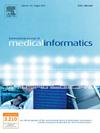Explainability and uncertainty: Two sides of the same coin for enhancing the interpretability of deep learning models in healthcare
IF 3.7
2区 医学
Q2 COMPUTER SCIENCE, INFORMATION SYSTEMS
International Journal of Medical Informatics
Pub Date : 2025-02-21
DOI:10.1016/j.ijmedinf.2025.105846
引用次数: 0
Abstract
Background
The increasing use of Deep Learning (DL) in healthcare has highlighted the critical need for improved transparency and interpretability. While Explainable Artificial Intelligence (XAI) methods provide insights into model predictions, reliability cannot be guaranteed by simply relying on explanations.
Objectives
This position paper proposes the integration of Uncertainty Quantification (UQ) with XAI methods to improve model reliability and trustworthiness in healthcare applications.
Methods
We examine state-of-the-art XAI and UQ techniques, discuss implementation challenges, and suggest solutions to combine UQ with XAI methods. We propose a framework for estimating both aleatoric and epistemic uncertainty in the XAI context, providing illustrative examples of their potential application.
Results
Our analysis indicates that integrating UQ with XAI could significantly enhance the reliability of DL models in practice. This approach has the potential to reduce interpretation biases and over-reliance, leading to more cautious and conscious use of AI in healthcare.
可解释性和不确定性:增强医疗保健领域深度学习模型的可解释性是同一枚硬币的两面
深度学习(DL)在医疗保健领域的应用越来越多,这凸显了对提高透明度和可解释性的迫切需求。虽然可解释的人工智能(XAI)方法提供了对模型预测的见解,但仅仅依靠解释不能保证可靠性。目的提出将不确定性量化(UQ)与XAI方法相结合,以提高医疗保健应用中模型的可靠性和可信度。方法我们研究了最先进的XAI和UQ技术,讨论了实现挑战,并提出了将UQ与XAI方法结合起来的解决方案。我们提出了一个框架来估计XAI上下文中的任意不确定性和认知不确定性,并提供了它们潜在应用的说明性示例。结果UQ与XAI相结合可以显著提高DL模型的可靠性。这种方法有可能减少解释偏差和过度依赖,从而在医疗保健中更加谨慎和有意识地使用人工智能。
本文章由计算机程序翻译,如有差异,请以英文原文为准。
求助全文
约1分钟内获得全文
求助全文
来源期刊

International Journal of Medical Informatics
医学-计算机:信息系统
CiteScore
8.90
自引率
4.10%
发文量
217
审稿时长
42 days
期刊介绍:
International Journal of Medical Informatics provides an international medium for dissemination of original results and interpretative reviews concerning the field of medical informatics. The Journal emphasizes the evaluation of systems in healthcare settings.
The scope of journal covers:
Information systems, including national or international registration systems, hospital information systems, departmental and/or physician''s office systems, document handling systems, electronic medical record systems, standardization, systems integration etc.;
Computer-aided medical decision support systems using heuristic, algorithmic and/or statistical methods as exemplified in decision theory, protocol development, artificial intelligence, etc.
Educational computer based programs pertaining to medical informatics or medicine in general;
Organizational, economic, social, clinical impact, ethical and cost-benefit aspects of IT applications in health care.
 求助内容:
求助内容: 应助结果提醒方式:
应助结果提醒方式:


